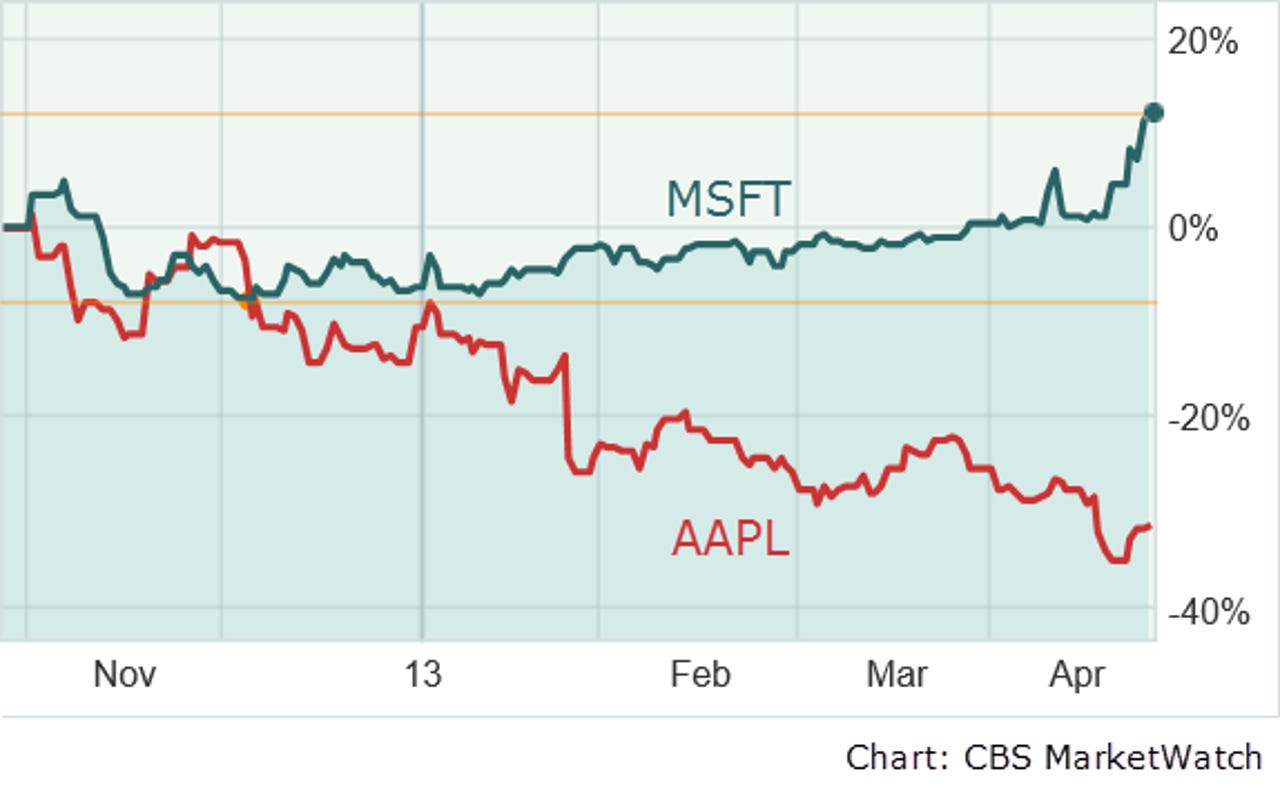Apple versus Microsoft: the ticker tape tells the tale

Windows 8 was released to the general public exactly six months ago.
During that time, the PC industry has contracted sharply and Windows 8 buyers have been less than fully enthusiastic.
The conventional wisdom is that Microsoft is flailing and Apple is a productivity machine. Apple’s products are uniformly loved and Microsoft’s are unable to get any traction. Apple's cool, Microsoft's not.
And yet the company’s stock prices have gone in completely opposite directions since the launch of Windows 8. This chart begins on the day Windows 8 was released to the public.

Now, the market has been known to be dead wrong before. But it’s odd to see this big a divergence between public perception and market performance.
Last week Microsoft released its quarterly results. This week Apple weighed in with its numbers. That gave me a chance to look at both companies in a little more detail. And when I did, I saw far more similarities than differences, including two CEOs who have drawn their share of fire from critics who think they need to be replaced.
At Microsoft, Steve Ballmer gets dinged for the company’s inability to make any serious inroads into the mobile category. After six months on the market, neither Windows Phone 8 nor Windows 8 have managed to get out of the single digits in terms of usage.
And yet the company managed to increase its profit 19 percent over the corresponding quarter last year. How? By concentrating on the boring, yet highly profitable units that most tech bloggers yawn at. Microsoft Business Division (responsible for Office 365, which is about to become a billion-dollar business) and Server and Tools (with multiple billion-dollar businesses under its umbrella) are both bigger than Windows.
Meanwhile, the Windows Division reported flat revenues even though PC shipments dropped by 14 percent during the same period. I’ve read several critiques from armchair financial analysts implying that Ballmer and Co. are somehow cheating by including its new Surface hardware line in the Windows Division’s results.
But that’s Microsoft’s strategy for Windows, part of its initiative to become a “devices and services” company. You can argue about the execution of that strategy, and you can place bets on whether it will succeed. But there’s nothing timid or tentative about it.
And then there’s Apple. Superficially, its business looks as diversified as Microsoft’s, with revenue and profits coming from a variety of products.
But in the same quarter where Microsoft's profits were up 19 percent, Apple's were down almost 18 percent.
There’s no question that Apple will sell lots more iPhones and iPads. But as CEO Tim Cook acknowledged on the earnings call, “We acknowledge that our growth rate has slowed and our margins have decreased from the exceptionally high level we experienced in 2012.”
In developed markets, Apple has masterfully executed against its plan to sell high-priced, high-margin products to the wealthier segments of the buying public. But there’s evidence that that market is saturated, and the first-mover advantage is gone. On the same earnings call, Cook conceded as much: “We can't control items such as exchange rates and world economies and even certain cost pressures.” Growth for Apple in its existing product lines means appealing to more price-conscious buyers and moving into markets where the $618 average selling price of an iPhone isn’t an option.
Is there another breakthrough hardware product in Apple’s back pocket? It’s hard to believe that a smart watch or a TV has the potential to define a category as the iPhone and iPad did.
Maybe services? Revenue on the iTunes/Software/Services line in Apple’s just-completed quarter was up 30 percent. But as the latest 10-Q report makes clear, that’s a by-product of the larger installed base of iOS devices:
This increase was due primarily to growth of iTunes [which] reflects continued growth in the installed base of iOS devices and expanded iTunes digital content and applications offerings around the world, resulting in higher net sales on the App Store and higher net sales of digital content.
Outside of iTunes, Apple hasn’t exactly excelled at delivering services to its own customer base, let alone expanding those services to a larger market. So it’s hard to see that as a real growth opportunity.
Indeed, that’s the real difference between Steve Ballmer’s Microsoft and Tim Cook’s Apple. Ballmer has a significant challenge in one division that represents about a quarter of his company’s revenue, while other divisions are growing steadily outside the gaze of the gadget-obsessed tech press.
Meanwhile, Apple has become downright boring and predictable. As Felix Salmon wrote after seeing Apple’s latest numbers:
Today’s earnings report marks the point at which Apple is officially no longer a high-growth tech stock, valued on its monster potential. Instead, it has become a cash cow, valued on its ability to pump hundreds of billions of dollars into its shareholders’ pockets.
That's actually a fairly accurate description of Microsoft's performance in the Ballmer era. And given the challenges of the economy and a fickle technology market, it's a significant accomplishment for both men.
In short, regardless of the stock market's vicissitudes, neither company is doomed. And I suspect neither CEO is going anywhere soon.